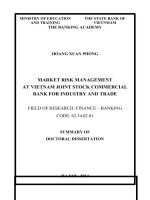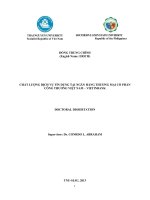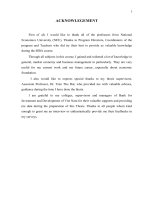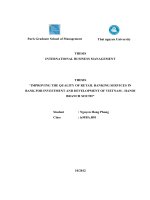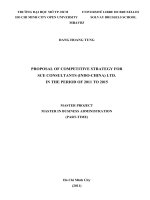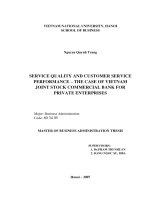Formulating business strategies for retail banking business of joint stock commercial bank for investment and development of Vietnam in the period of 2013 – 2017
Bạn đang xem bản rút gọn của tài liệu. Xem và tải ngay bản đầy đủ của tài liệu tại đây (1.7 MB, 82 trang )
CAPSTONE PROJECT REPORT
FORMULATING BUSINESS STRATEGIES FOR RETAIL BANKING
BUSINESS OF JOINT STOCK COMMERCIAL BANK FOR INVESTMENT
AND DEVELOPMENT OF VIETNAM
IN THE PERIOD OF 2013 - 2017
Class: GaMBA.M0111
Group 5:
1. Pham Viet Anh
2. Nguyen Hoai An
3. Le Thi Bich Hanh
4. Nguyen Chien Thang
November 2012
CapstoneProject_G5.GaMBA.M0111
Page 1
STATEMENT OF AUTHORSHIP
& ACKNOWLEDGEMENT
After a period of research and synthesis, with the hard work and efforts of the
group members, we have completed this Capstone Project Report. The group affirms
that this is the research of our group. The data published in this report which is taken
from research, reports and articles of organizations and individuals, is quoted and
used appropriately in accordance to the academic regulations. The results presented
in this report are valid and have not been published in any other research.
We would like to express our deepest thanks to Griggs University, ETC –
Vietnam National University – Hanoi and our lecturers for giving us valuable
guidance and advice. Sincere thanks should also go to the staff of ETC for providing
us with dedicated support during the course.
Finally, the group would like to thank Joint Stock Commercial Bank for
Investment and Development of Vietnam (BIDV) for helping us in the process of
doing this research by providing us with useful data and information, enabling us to
complete this Capstone Project.
Hanoi, November 15th, 2012
GROUP OF AUTHORS
CapstoneProject_G5.GaMBA.M0111
Page 2
LIST OF TABLES
Table 1.1
SWOT Matrix
Table 1.2
Quantitative Strategic Planning Matrix (QSPM)
Table 2.1
Account outstanding of different banks
Table 2.2
Mobilizing capital from individual deposit
Table 2.3
Position of banks in domestic debit card
Table 2.4
Position of banks in international credit card
Table 2.5
Table 2.6
Position of banks in POS
Insurance exploitation of banks
Table 2.7
Table 2.8
Remittance activities of banks
External Factor Evaluation - EFE Matrix
Table 2.9
Table 2.10
Consolidated Balance Sheet
Income Statement for Business Divisions
Table 2.11
The capital adequacy ratio(CAR) of other banks
Table 2.12
Internal Factor Evaluation – IFE Matrix
Table 2.13
Table 2.14
Competitive Profile Matrix (CPM)
SWOT analysis
Table 3.1
Comparison of alternative strategies using QSPM
Strategy implementation plan for retail banking business of BIDV in
the period of 2013-2017
Table 3.2
LISTS OF FIGURES
Figure 1.1
Figure 1.2
Figure 2.1
Figure 2.2
Figure 2.3
Figure 2.4
Figure 2.5
Figure 2.6
Figure 2.7
Figure 2.8
Figure 2.9
Business strategic management process
The Five Forces Model of Michel E. Porter
The organizational structure of BIDV
Vietnam’s GDP growth rate from 2005-2011
CPI growth of Viet nam from 2005–2011
Total assets scale of BIDV compared to other banks
Total equity scale of the BIDV compared to other banks
Gross profit of BIDV compared with other banks
The distribution channel systems of branches
The ATM and POS distribution channel systems
The credit rating options (BEINorm)
CapstoneProject_G5.GaMBA.M0111
Page 3
CONTENTS
INTRODUCTION .....................................................................................................6
CHAPTER I: THEORETICAL FRAMEWORK FOR BUSINESS STRATEGY
FORMULATION ......................................................................................................9
1.1 Basic concepts of strategy and business strategy: ................................................. 9
1.1.1 Definition of strategy: .................................................................................. 9
1.1.2 Business strategy: ........................................................................................ 9
1.1.3 The roles of business strategy .................................................................... 10
1.2 The process of strategy formation ....................................................................... 10
1.2.1 Strategic vision and mission statements .................................................... 11
1.2.2 Strategic objectives .................................................................................... 11
1.2.3 Analysis of external environment .............................................................. 11
1.2.4 Internal environment analysis ................................................................... 15
1.2.5 Formulating alternative strategies and selecting appropriate
strategies .................................................................................................... 16
1.2.6 Developing an action plan and implementation solutions ........................ 17
1.2.7 Review and adjustment .............................................................................. 17
1.2.8 SWOT Matrix ............................................................................................ 17
1.3 Business strategy selection ................................................................................ 19
1.3.1 Generic competitive strategies .................................................................. 19
1.3.2 Quantitative strategic planning matrix (QSPM) ....................................... 19
CHAPTER II: ANALYSIS OF STRATEGIC BUILDING FOUNDATION FOR
RETAILING ACTIVITIES OF BANK FOR INVESTMENT AND
DEVELOPMENT OF VIETNAM JSC ................................................................21
2.1 Introduction of BIDV ........................................................................................ 21
Fields of operation .............................................................................................. 21
History of establishment and development ......................................................... 22
Organizational structure .................................................................................... 22
2.2 Analysis of BIDV business environment ......................................................... 24
2.2.1 Analysis of macro environment influence on BIDV’s performance .......... 24
2.2.2 Analysis of industry influence on retail activities of BIDV ....................... 30
2.2.3 Analysis of BIDV's internal environment of BIDV .................................... 38
2.2.4. Competitive Profile Matrix (CPM) ........................................................... 56
2.3. The summarization of SWOT analysis of BIDV’s retail operation ................ 58
CHAPTER III: STRATEGY SELECTION AND IMPLEMENTATION
SOLUTIONSTO DEVELOP RETAIL BANKINGBUSINESS OF BIDV ........61
3.1 BIDV’s vision, mission and strategic goals .................................................... 61
CapstoneProject_G5.GaMBA.M0111
Page 4
3.2 Strategy selection for the development of retail banking of BIDV in the
period of 2013 - 2017 ......................................................................................... 62
3.2.1 Summarization of the strategies from SWOT analysis .............................. 62
3.2.2 Selecting business strategies for retail banking of BIDV – using
QSPM matrix.............................................................................................. 62
3.3 Strategic solutions ............................................................................................. 65
3.3.1 Solutions of investing in equipment and IT system .................................... 65
3.3.2 Product and service solutions.................................................................... 66
3.3.3 Customer solutions .................................................................................... 69
3.3.4 Distribution channel solutions................................................................... 70
3.3.5 Solutions in terms of supporting policies .................................................. 72
3.3.6 Developing and reinforcing the human resources, building BIDV
corporate culture........................................................................................ 72
3.3.7.Enhancing the marketing programs for retail activities ........................... 74
3.4 Implementation Plan .........................................................................................75
CONCLUSIONS .....................................................................................................81
REFERENCES ........................................................................................................82
CapstoneProject_G5.GaMBA.M0111
Page 5
INTRODUCTION
1. The necessity of the research topic:
The focus of expansion and development of the retail sector will be the
decisive factor affecting the leading role of commercial banks in the future. This is an
inevitable trend of the banking sector in Vietnam when the international economic
integration is more intensive and competitive, the utility needs of people are the
increasingly diverse, and commercial banks are trying to expand their market share,
access to a large amount of people who still do not know the banking products and
services. Further, retail banking services bring higher revenue and less risky for
banks. In fact, the commercial banks in Vietnam have initially focused on exploiting
the retail markets through the expansion of the network activity in order to provide
banking products and services to individuals and households; promoting applications
in banking technology, developing of new services, multi-utilities such as internet
banking, home banking, mobile banking, etc.
This is considered as one of the trend in choosing the long-term growth if banks
want to continue maintaining and expanding market share in the future. Retail
development helps banks with larger market, higher economic efficiency because
products are offered in bulk to large number of customers, which generates more
sales and distributes business risks.
Vietnam is considered to be a market with a lot of potential retail banking
development. The attraction of retail banking operations has been confirmed.
Therefore, not only domestic commercial banks but also foreign banks are looking
for ways to penetrate deeper into Vietnam market. Potential business market with
increasing competition force banks to have effective business strategy, and the Bank
for Investment and Development of Vietnam (BIDV) is not an exception.
BIDV has been known as a bank operating mainly in the field of wholesale and
retail operations have accounted for only a small percentage and have-not been
focused for the development. BIDV takes many advantages for retail development
but so far this activity has not developed commensurate with the potential and
advantages.
With the goal of becoming a universal bank with large scale in the region,
BIDV must diversify its business areas, maintain the strength of a wholesale bank,
the bank should also promote effective strategies for retail operations. From this
necessity, our team has selected the theme: “Formulating strategies for retail
banking business of Joint Stock Commercial Bank for Investment and
Development of Vietnam during the period 2013 - 2017” with the desire to apply
CapstoneProject_G5.GaMBA.M0111
Page 6
our knowledge to contribute to the overall development of the bank.
2. Research purposes:
- Systematize a theoretical basis for business strategy and effective methods to
choose appropriate analysis models for business strategy formulation
- Apply this theoretical basis to focus on situational analysis and capacity
evaluation of the BIDV in the deployment of retail banking services.
- Propose solutions and recommendations for further development of the bank's
retail banking activities.
3. Subject and scope of the research:
- Subject: Retail Activities at the Bank for Investment and Development of
Vietnam.
- Scope of research: the entire system of the Bank for Investment and
Development of Vietnam.
Retail banking can be considered as a strategic business unit (SBU) of BIDV
because of the following reasons:
Retail banking department (“Department”) is an independent and fully
functional department operated as both cost and profit center of the branch.
BIDV has fully delegated authority and responsibility to a director of the
department who reports directly to the Management Board of BIDV.
The Department has its own budget, marketing plan, competitors as well as
manpower. The contribution in terms of money of the department is clearly
calculated and monitored by BIDV.
BIDV implement retail banking activities since 2009 and has independent parts
management and implementation of retail banking activities. However, the retail
banking activities are spontaneous and haven’t a clear strategy
4. Research methodology:
The data were collected and compiled from the annual reports, financial
statements, from the website of BIDV and other banks, the published information
from the State Bank and other reference materials, books, magazines, specialized
teaching materials.
We have consulted BIDV experts in the assessment of weight in the process of
analyzing the matrix.
Our group mainly base on statistical method, method of analysis, comparison,
and synthesis to conduct the research.
5. Structure:
CapstoneProject_G5.GaMBA.M0111
Page 7
In addition to the introduction, conclusion, references, the project consists of
three chapters:
Chapter 1: Theoretical framework for business strategy formulation
Chapter 2: Analysis of the foundation for formulating business strategies for
retail activities of Joint Stock Commercial Bank for Investment and Development of
Vietnam.
Chapter 3: Strategy selection and implementation solutions to develop retailbanking activities of BIDV in the period 2013 - 2017
Hanoi, November 15th, 2012
CapstoneProject_G5.GaMBA.M0111
Page 8
CHAPTER I:
THEORETICAL FRAMEWORK FOR BUSINESS
STRATEGY FORMULATION
1.1 Basic concepts of strategy and business strategy:
1.1.1 Definition of strategy:
There are many different definitions of strategy; opinions of approach have
steadily converged to create a relative united definition of strategy: strategy can be
understood as “a coordinated series of actions which involve the deployment of
resources to which one has access for the achievement of a given purpose”
Whatever approach we apply in each perspective and definition, there are three
common characteristics of strategy:
- Establishment of an overall course of actions to wards the long-term goals in
the future;
- Key policies and measures to implement the program;
- Establishment of action sequences, ways to proceed and allocate resources to
achieve the goals.
1.1.2 Business strategy:
1.1.2.1 Definition of business strategy
Business strategy is business-orientation with goals in a long time period along
with policy systems, measures and ways to allocate resources to achieve the objective
of the business in the corresponding period of time.
Thus, the business strategy of an enterprise must be goal-oriented, long-term
and must be done as a deliberate process.
1.1.2.2 Classification of business strategy
There are many ways to classify business strategy, which creates diversity in
the methods of implementing business strategy.
Classification of business strategy by levels:
- Corporate-level strategy
- Business-level strategy
- Functional-level strategy
Classification of business strategy by strategic process:
- Orientation strategy
- Action strategy
CapstoneProject_G5.GaMBA.M0111
Page 9
1.1.3 The roles of business strategy
Business strategy is increasingly becoming a tool to orientate the business
development with goals that are in accordance with objective conditions of the
business environment.
Business strategy helps enterprises understand and take advantage of the
business opportunities from the business environment; more over, it can capture the
most profitable opportunities to achieve its goals.
1.2 The process of strategy formation
In order to create a strategy, it is necessary to have a strategic mindset and have
answers to three questions: "Where are we now? Where do we need to go? And how
do we get there?” through the following steps
Figure 1.1: Business strategic management process
Inputs
Internal
enviroment
Strategic Intent
Strategic Mission
Stategic
Incoes
Strategic Actions
External
enviroment
Strategy formulation
Business level strategy
Acquisitions
and
Restructuring
Competivity
Dynamics
International
Strategy
Strategy implementation
Corporate Level Strategy
Corporate
Covernance
Structure &
Control
Cooperative
Strategy
Strategic
Leadership
Enterpreneurship
Inovation
Strategic
Competitiveness
Above Average
Return
Feedback
Source: Strategic management Textbook–Griggs University
CapstoneProject_G5.GaMBA.M0111
Page 10
1.2.1 Strategic vision and mission statements
Mission is a concept describing the highest purpose, the meaning of the
establishment and survival of the business. However, in the each period, strategy
must be specified in strategic objectives appropriate to each stage.
Vision means a statement about the position where the company desires. It is an
outline of the company's objectives and goals in the future.
1.2.2 Strategic objectives
Strategic objectives are milestones, positions that enterprises want to achieve in
each strategic phase.
It can be seen that the business strategy is formed on the balance among the
three elements:
- Strategic objectives(the desire of business).
- Business Environment(the external constraints of the enterprise).
- Enterprise Competencies(the internal constraints).
1.2.3 Analysis of external environment
The objective of the analyzing the external environment is to identify
opportunities and challenges for enterprises, to find ways to deploy and capture
opportunities from the environment, and to avoid the necessary challenges for the
enterprises.
The scope and content of the environment analysis include: analysis of the
macro environment and micro environment, also known as environmental sector.
1.2.3.1 Macro environment analysis – PEST model
The analysis and synthesis of elements exist outside the enterprise affect the
survival and development of enterprises. Enterprises need to realize the opportunities
and challenges from objective environment, they also need to adapt, and promote
environmental changes. The macro-environmental factors:
Analysis of legal and political factors (P)
Politics are political factors and circumstances in which their operations affect
the enterprises. These factors include: the political regime, the regime of political
parties, political organizations, the motto of the Party and State's policies, sociopolitical atmosphere.
Law is the legal system relating to business, including the State's legal, legal
awareness of the judiciary, law enforcement agencies and businesses.
The impacts of political and legal environment on business activities of the
enterprises are extensive, sometimes are decisive factors. In general, if a country is
CapstoneProject_G5.GaMBA.M0111
Page 11
stable in terms of politics with clear and consistent policies, good political
atmosphere, strict law, enterprises can develop a healthy and stable business
environment.
Analysis of economic factors (E)
Economic factors are the socio-economic situation and economic policy of the
country where the enterprise establish and develop. Macroeconomic environment
includes: socio-economic structure, level of economic development, the economic
regime and macro-economic policies.
Analysis of socio – cultural factors (S)
Social factors: including the formation and changes of the social class, the
population size, age structure, geographic distribution, population structure, the
movement of the population, the power structure, living and working methods of the
people. Present situation and the volatility of these factors can affect the business
operations of the enterprises.
Cultural factors: including elements of philosophy, religion, language, literature
and arts. The impact of these factors on the business of the enterprise is mainly
indirect effects and they cannot be overlooked.
Analysis of technological factors (T)
Factors of engineering science and technology are all social phenomena directly
related to the engineering science and technology factors where the enterprises
establish and develop, including four factors: qualifications, forces, regimes of the
State; policies and the laws of science and technology.
Analysis of natural factors (+)
Geographical location, climate, topography, etc. are very important factors that
directly affect the business of the enterprise. The climate changes are not predictable
and sometimes become threats to businesses that produce their seasonal services.
Existing infrastructure is also considered as a part of the natural elements that
has an important influence on the organization of activities, cost calculation of the
business.
1.2.3.2 Analysis of industry environment
In any industry, each business is subject to competitive pressures from 5 forces
Analysis of Michel E. Porter’s Five Forces Model, helps the strategists analyze
the above forces - structure of the industry, which is summarized in the following
figure:
CapstoneProject_G5.GaMBA.M0111
Page 12
Figure 1.2: The Five Forces Model of Michel E.Porter
Competitive forces
(Michael E. Porter, 1980s)
Potential
competitors
Bargaining power of
suppliers
Suppliers
Threat of
new entrants
Existing
Competitors
Rivalry within
the industry
Buyers
Bargaining power of
Buyers
Threat of
Substitutes
Substitutes
Source: Strategic management Textbook–Griggs University
- Competitive pressure from existing competitors: The competition among firms
in the same industry reveals the patterns of competition, the nature of competition.
Competition relates to the elements of an industry’s characteristics, structure of
business scale in an industry, the number of firms in an industry, and the market
structure of the industry.
- Threat of potential competitors: a new entrant can be a business that has just
been established or an enterprise that produced other products in the past, and now
produce many products. These businesses bring new production capacity, and also
require a certain market share.
- Bargaining power of buyers: Customers of enterprises could be direct and end
consumers of goods. When consumers require cheaper prices, better quality and
better after-sales services, they put a pressure on that industry. Customers could be a
distributor, or dealer. The most importance is: who are the main customers with
strong bargaining power that business must pay special attention to.
- Bargaining power of suppliers: Suppliers of raw materials, equipments have
the ability to increase prices or lower the quality of products or both. Enterprises
should negotiate with suppliers to resolve and achieve the main requirements:
standard, quality; ability of quantity providing; price, ability of capital, and return on
capital.
- Threat of substitute products and services: substitute products are products of
similar use. If the profits of substitute products are high, competitive pressure
CapstoneProject_G5.GaMBA.M0111
Page 13
(pressure on production costs and selling prices) is also high and the business is put
on the passive and defensive position. If the manufacturer of substitute products
rapidly develops its products, that industry will be strongly affected. If consumers
comfortably accept the substitutes in terms of economic as well as psychological
matter, that influence is greater.
In summary, analysis of the business environment is extremely important for
enterprises. Business environment includes macro economic environment and
industry environment. The goal of this analysis is to identify opportunities and
threats. Based on this, managers will make rational management decisions.
1.2.3.3 External factor evaluation matrix – EFE
The external factor evaluation matrix helps strategists summarize and evaluate
the information of economic, social, cultural, demographic, geographic, political,
governmental, legal and technological factors. There are five steps to develop an EFE
Matrix
- Step 1: Make a list of 10 to 20 factors of opportunities and threats that
influence the success of the business in the industry as identified in the process of
external environment analysis.
- Step 2: Each factor will be given a weight of importance from 0.0 (not
important) to 1.0 (very important). This classification shows the respective
importance of each factor to the success of the business. The total value of the weight
for all factor’s level of importance must be 1.0.
- Step 3: Assign a rating between 1 and 4 to each factor that decides the
business success to evaluate how the current business strategy responds to that factor:
4 = the response is superior, 3 = the response is above average, 2 = the response is
average and 1 = the response is poor. These ratings are given based on the
effectiveness of the current business strategy. Thus the ratings in this step bases on
firm size, while the second step bases on the industry.
- Step 4: Multiply each factor’s weight with its rating to calculate the weighted
score for each factor.
- Step 5: Add all weighted score of all factors to identify the total weighted
score for the company.
The total score of the matrix does not depend on the number of factors in the
matrix, the highest score is 4 and the lowest is 1. If the total weighted score is 4, the
business response well to opportunities and threats, if the total weighted score is 2.5,
the business has average ability to response to opportunities and threats. If the total
CapstoneProject_G5.GaMBA.M0111
Page 14
weighted score is 1, the enterprise response poorly to external opportunities and
threats
1.2.4 Internal environment analysis
In addition to the analysis of the external environment that helps businesses
identify opportunities and threats from the external environment, strategic planners
should understand the internal environment in order to have a comprehensive and
overall viewpoint about the strengths and weaknesses of their organization.
1.2.4.1 Analysis of resources.
Resource analysis shows the resources reserves, capabilities, and available
business properties. Analysis should take into account main resources such as:
- Financial capacity.
- Infrastructures
- Human resources
- Machinery and equipments
- Technology
1.2.4.2 Research and Development capability (R&D)
Research and development can help businesses keep the leading position in the
industry or vice versa, make the enterprises lag behind the leading ones. Therefore,
enterprises must regularly change and innovate technology, products and materials....
1.2.4.3 Production capacity
Manufacturing is one of the main activities of the enterprise with the creation of
products, which has strong influence on the success of the business. The production
of relatively high-quality products with a relatively low price will bring many
benefits to enterprises because the products are easier to sell, and saving financial
resources will create a positive attitude among employees.
When analyzing the factors of production are, we should pay attention to: the
price and the level of material supply, inventory turnover levels, allocation of means
of production, productivity and cost of the equipments, cost and technological
capabilities compared to the industry and the competitors, etc.
1.2.4.4 Financial potentials
When analyzing the financial and accounting factors, managers should focus
on: the ability to mobilize short-term and long-term capital; total capital of the
enterprise; the flexibility of capital investment structure; utilization of financial
strategies; ability to control cost reduction; effective accounting system, cost
planning, financial planning and profit, etc.
CapstoneProject_G5.GaMBA.M0111
Page 15
1.2.4.5 Marketing capability
Marketing can be described as a process of identifying, forecasting, setting and
meeting the desired demands of the consumers towards products and services.
Marketing includes 9 basic functions (1) customer analysis; (2) buying; (3) selling;
(4) products and services planning; (5) pricing; (6) distribution; (7) market research;
(8) opportunity analysis; (9) social responsibility. The successful implementation of
the marketing function will help us to identify and assess the strengths and
weaknesses of marketing activities.
1.2.4.6 Internal factor evaluation matrix – IFE
This strategy formulation tool summarizes and reviews the important strengths
and weaknesses of a business unit, and it also provides the basis for identifying and
assessing the relationships among these units. An IFE Matrix can be developed in
five steps:
- Step 1: Make a list of 10 to 20 elements including the strengths and
weaknesses that affect the development of the business.
- Step 2: Assign a weight of importance that ranges from 0.0 (not important)
and 1.0 (all- important) to each factor. The weight indicates the relative importance
of that factor to being successful in the industry. Regardless of whether it is an
internal strength or weakness, the factor is considered the most influential to the
performance of the organization must be the most important ones. Total value of all
weights is 1.0.
- Step 3: Assign a 1-to-4 rating to each factor to indicate whether that factor
represents a major weakness (rating =1), a minor weakness (rating – 2), a minor
strength (rating = 3), or a major strength (rating = 4). Thus, this evaluation bases on
the business, while the evaluation of weights in step 2 bases on the industry.
- Step 4: Multiply each factor’s weight by its rating to determine a weighted
score for each factor;
- Step 5: Add all the weighted scores of all factors to identify the total weighted
score for the organization.
Regardless of how many factors are included in an IFE Matrix, the total
weighted score can range from 1.0 to 4.0. The total weighted score below 2.5
indicates that the business is weak internally. The total weighted score above 2.5
characterizes that the business is strong internally
1.2.5 Formulating alternative strategies and selecting appropriate strategies
Strategic analysis and selection mean making subjective decisions on the basis
of objective information. Strategic analysis and selection are to determine the activity
CapstoneProject_G5.GaMBA.M0111
Page 16
options that help the company fulfill the responsibilities and objectives. Strategies,
objectives and mission of the company with the internal and external information will
provide the basis for the formation and evaluation of feasible strategies.
1.2.6 Developing an action plan and implementation solutions
The implementation of strategy should focus mainly on the following
management issues:
- Establishing annual goals.
- Establishing policies.
- Allocation of resources is the center management activity in the strategy
implementation process
- Conflict management
- Aligning structure with strategy.
- Aligning compensation with strategy.
- Change management - managing the anti-change thoughts
- Creating corporate culture supporting strategies
1.2.7 Review and adjustment
A rigid and inflexible strategy will not be suitable when the external or internal
environment of the business changes. So the strategists need to review, evaluate and
adjust the strategy implementation. The criteria to evaluate strategies:
- Consistency.
- Appropriateness.
- Feasibility.
- Advantages.
Successful evaluation allows businesses to take advantage of internal strengths,
exploit external opportunities, realize and cope with external threats as well as
overcome internal weaknesses before they become hazardous.
1.2.8 SWOT Matrix
1.2.8.1 General theory of SWOT
While PEST analysis is a tool related to external factors, SWOT analysis
focuses on the internal changes related to the external factors.
SWOT is an extremely useful tool that helps us understand the problems or
make decisions related to the organization, management as well as business
activities. In other words, SWOT is a framework that helps us to review the
strategies, determine the position and direction of a company, analyze business
CapstoneProject_G5.GaMBA.M0111
Page 17
proposals or any ideas related to the interests of the business. SWOT analysis is a key
to strategic development, clarifying the internal strengths of the organization;
weaknesses, opportunities as well as challenges from external environment.
1.2.8.2 SWOT Matrix
SWOT Matrix is used to synthesize the research on external and internal
environment of a business (or an industry). Analysis of the external environment
helps to discover opportunities and threats to the business. Internal environment
analysis helps to identify the strengths and weaknesses of the business.
On the basis of analyzing the factors in the matrix, the objectives, direction of
business development and its resources, business can set up various combinations. In
principle, there are four types of combinations:
- Opportunities with strengths (OS);
- Opportunities with weaknesses (OW);
- Threats with strengths (TS);
- Threats with weaknesses (TW)
To develop strategies basing on the SWOT analysis, the company should
establish a SWOT matrix (also known as TOWS matrix) as shown below:
Table 1.1: SWOT Matrix
Opportunities (O)
SWOT Matrix
Threats (T)
1...
2...
Strengths (S)
1...
2...
3...
Weaknesses (W)
1...
2...
3...
1...
2...
SO Strategies
ST Strategies
Strategies to use the
business’s internal strengths
to take advantage of
external opportunities.
Strategies to use the
business’s strengths to cope
with or avoid external
threats
WO Strategies
WT Strategies
Strategies to overcome the Strategies to overcome
business’s weaknesses to weaknesses of the business
take advantage of external to avoid external threats
opportunities
In the current context of globalization, economic and cultural exchanges with
other countries are inevitable and enterprises also face risks in the market. SWOT
CapstoneProject_G5.GaMBA.M0111
Page 18
analysis will help businesses measure and evaluate accurately before deciding to
enter the international market.
1.3 Business strategy selection
1.3.1 Generic competitive strategies
Enterprises pursuing corporate-level strategies try to achieve competitive
advantage, better performance and above average return. They often choose from
three generic strategies: Cost-leadership, Product differentiation and Focus.
1.3.1.1 Cost-leadership strategy
The goal of the cost-leadership company is to create competitive advantage by
creating products with the lowest cost.
1.3.1.2 Product differentiation strategy
The goal of the company with product differentiation strategy is to achieve
competitive advantage through the creation of special and unique products, satisfying
customer needs in the ways that competitors cannot perform.
1.3.1.3 Focus strategy
Focus strategy meets the demand of a particular market segment through
geography, customer or product nature.
1.3.2 Quantitative strategic planning matrix (QSPM)
This method will choose one strategy among a wide range of options given on
the basis of evaluation criteria such as business value, revenue, profits, investment
levels, competitive advantage, suitability with the current culture of the business,
time ... to find the best strategy in the given strategies. This method involves 5 steps:
Step 1: Select some of the most important factors (including internal and
external factors), in accordance with the characteristics of business to assess the
competitive strategies such as enterprise value, revenue, profit, risk level, investment
level, competitive advantage ... This is a subjective step of the selector.
Step 2: Assign weights to each key external and internal factor to determine the
importance of these factors on the final decision.
Step 3: Determine the Attractiveness Scores (AS) for each factor. The range for
AS is: 1 = not attractive, 2 = somewhat attractive, 3 = reasonably attractive, 4 =
highly attractive.
Step 4: Calculate the Total Attractiveness Scores by multiplying the weights by
the Attractiveness Score in each row
CapstoneProject_G5.GaMBA.M0111
Page 19
Step 5: Calculate the Sum Total Attractiveness Score by adding Total
Attractiveness Scores in each strategy column of the QSPM. The strategy with the
highest Sum Total Attractiveness Score will be selected.
Table 1.2: Quantitative Strategic Planning Matrix (QSPM)
Alternative strategies
No
Key factors
Weight
Strategy
1
Strategy
2
Strategy
3
AS TAS AS TAS AS TAS
External factors
1
2
…
Internal factors
1
2
…
Total
CapstoneProject_G5.GaMBA.M0111
Page 20
CHAPTER II:
ANALYSIS OF STRATEGIC BUILDING FOUNDATION
FOR RETAILING ACTIVITIES OF BANK FOR INVESTMENT AND
DEVELOPMENT OF VIETNAM JSC
2.1 Introduction of BIDV
-
Registered name: Bank for Investment and Development of Vietnam Jsc.
English name: Joint Stock Commercial Bank for Investment and Development
of Vietnam
- Abbreviation: BIDV
- Charter capital: 23,011,705,420,000 VND
- Head quarter: BIDV Building, 35 Hang Voi St., HoanKiem District, Hanoi
- Website: www.bidv.com.vn
- Business registration:
License of establishment and operation for commercial bank, No.
84/GPNHNN, dated April 23rd2012.
Certificate of business registration No. 0100150619, first registered on April
2nd 1993, changed the thirteenth time on April 27th2012, issued by Hanoi
Department of planning and investment
The structure of charter capital of Joint Stock Commercial Bank for
Investment and Development of Vietnam was approved by the Prime Minister,
in decision No. 278/QDD-TTg, dated March 7th 2012
Shareholder structure
No.
Shareholder
No. of share
Percent
age
1
State Bank (represent state budget)
2
Staff members
12.808.600
0,56%
3
Public
84.754.146
3,68%
2.301.170.542
100%
Total
2.203.607.796 95,76%
Fields of operation
BIDV is a joint stock commercial bank with different fields of operations:
Commercial bank activities: include financial activities such as capital raising,
credit facilities, payment and budget processing and other business and
commercial banking activities;
CapstoneProject_G5.GaMBA.M0111
Page 21
Retailing banking activities: provide and the develop products and services of
capital raising, lending and payment processing which satisfy all personal
needs for financial service; develop various card options.
Investment bank activities: perform the service of an investment bank under
direct or indirect methods through securities companies, trust funds, financial
companies or other forms of company that BIDV has share representation or
stock subscription according to the laws.
Insurance: BIDV perform insurance service under by means of establishing
relevant companies or agents for other insurance companies according to the
laws.
History of establishment and development
- Joint Stock Commercial Bank for Investment and Development of Vietnam,
formerly Bank of Construction of Vietnam, was established according to
decision No. 177/TTg by the Prime Minister, dated April 26th 1957, with the
primary functions of distributing and managing the capital from state budget
for basic construction plans in all economic and social fields.
- On September 11th 1994, the Prime Minister issued decision no. 654/QĐ-TTg
about transferring the responsibility of state budget and credit distributing
from BIDV to the Central board (belongs to Ministry of finance); on
November 18th 1994 the Governor of State Bank of Vietnam issued decision
No. 293/QĐ-NH9, which allowed BIDV to diversify its functions as a
commercial bank. BIDV has conducted critical stages of structure
reorganizing and business direction to become a multifunctional commercial
bank, aiming at gaining high profit.
- After 55 years of development, BIDV has become one of the biggest four
commercial banks in Vietnam, organizing activities in the format of a joint
stock commercial bank where the state budget controls the largest share.
Organizational structure
The current organizational structure of BIDV is displayed in the following figure:
CapstoneProject_G5.GaMBA.M0111
Page 22
Figure 2.1: Organizational Structure of BIDV
Board of Shareholders
Board of Directors
Risk Resolution Commitee
Supervisory Board
Credit Management Commitee
IT Commitee
The orther Council/Commitee
Board of Management
& Chief Accountant
Council/Commitee
ALCO Commitee
Credit Commitee
Wholesales
Banking
Retail Banking
& Network
Treasury
Risk
Management
Finacial
Institution Dept
Retail Banking
Development Dept
Treasury Dept
Credit Risk
Management Dept
Corporate Product
Development Dept
Branch
Management Dept
Corporate
Banking Dept
Card Center
Operations
Payment
Center
Finacial &
Accounting
Business
support
Customer
Services Center
Finance Dept
Human
resource Dept
Mis&ALCO
Dept
Corporate Planing &
Development Dept
Equitization Project
Management Dept
Legal Affair
Dept
Representative
in Myanmar
Credit Management
Dept
Administraion
Office
Trade Finance
Operation Center
Market & Operation
Risk Management
Dept
Accting Dept
Brand & PR
Managememt Dept
Investment Dept
Representative
in Campuchia
Premis es & Facility
Managememt Dep
Representative
in HCM City
Northern
Contruction Project
Management Dept
Representative
in Danang City
Southern
Contruction Project
Management Dept
IT Center
Training School
Technology
Dept
Trade Union
Office
Party Office
Whole Owner
Subsidiaries
Administrative
Units
Branches and
Transaction Center
Joint Ventures
Source: BIDV Annual Report 2011
CapstoneProject_G5.GaMBA.M0111
Page 23
Besides the representative system, BIDV has a system of member companies,
professional units and partner companies. Until September 30 2011, BIDV has a
network of banks including the head quarter and 118 representative office over 63
cities and provinces in the country, 379 transaction offices, 157 saving funds, 1,295
ATM stations and more than 6000 POS machines, one BIDV training institution, one
information technology center, one transaction center and representative in foreign
countries such as Cambodia, Myanmar, Laos and Czech Republic.
2.2 Analysis of BIDV business environment
Before going into the analysis, it is necessary to mention the perspective and
definition of BIDV for retailing activities. Each organization has its own definition of
retailing. However, BIDV considers that retail banking service includes all the activities
related to the products and services that BIDV offers to the individual customers or
households. These products and services are directly distributed through the electrical
communication and information technology system.
2.2.1 Analysis of macro environment influence on BIDV’s performance
* Political – Legal Factors
Political Factors
Vietnam is one the countries that is considered to have stable security, political
theme and gradually improved position in the world. This is an important factor in
attracting the foreign direct and indirect investment and it is also the foundation for
the development in manufacturing, commerce and infrastructure.
Vietnam has specified policies to advocate trade liberalization, free trade and
the application of market economy principle in banking industry since 2011. Also in
2007, Vietnam opened the gates for foreign banks after the country join WTO, which
opens a new playground for all banks. Foreign banks are able to libertize their
activities in finance sector while the domestic ones are bound to continuously
improve their products and services to compete in the open market
Legal factors
The legal foundation for banking activities has been improved and paid more
attention since the issue of the legal system for banking activities, dated December 12
1997, after two former legislative codes of Vietnam Banking Law and Credit
Organization Law replaced the previous ordinance from May 23 1990. Most recently,
the Vietnam Banking Law and Credit Organization Law have been edited and
approved in the XIIth Congress, and then it came into effect from January 1st 2011.
Besides, the Government and State Bank also issued various policies to manage
and control the economy to ensure the monetary security. Many policies have great
CapstoneProject_G5.GaMBA.M0111
Page 24
impact on all the banks’ activities. Examples of those are Resolution 11 of the
Government regarding the major solution to control inflation, stabilize the macro
economy and social security; requirement of ceiling interest rate for credit
institutions; requirement of the maximum proportion for credit growth and required
reserve, etc.
There are some decisions that support the development of the banking system,
such as: proposal for payment with cash, requirement of salary payment through
banking account, legal codes on electronic transactions, electronic signature,
electronic crime, and high technology crime. Those policies reduce the technological
crime and serve as the framework for the expansion of electronic banking, as well as
the well being of banking activities in general.
Although there are many significant improvements in completing the system of
legal documents, the framework for banking activities has yet uniform and
completed. Most of the policies are bureaucracy heavy, trifling and incoherent,
impeding the performance of commercial banks. The period of 2009–2012 observes
many changes monetary policies and commercial bank controlling by the
Government and State Bank. Within a very short period of time, the Government and
State Bank continuously launched directions which changed from the finance tighten
stage to control inflation and credit growth in 2009, to credit relaxation stage to boost
the economy in 2010, and then again back to finance tighten stage, restructure the
economy in 2011, which lasts until the middle November 2011 and the beginning of
2012, when the economy struggles and interest rates fluctuated unpredictably. The
State Bank twice conducted interest modification. This was considered a positive
move of the State Bank when inflation tended to slow down and the economy, as
well as the enterprises has to face many difficulties. In a broader viewpoint, the
lowering of interest rate helps loosen the finance market, which was severely
compressed by the monetary policies in 2011.
* Economic factors
The world economy is in an unstable stage. Banking activities are very sensitive
to the unexpected occurrence in the world, from the unstable political system in
Middle East, natural disaster in Japan, public debt in European countries to the
increased public debt ceiling in the US. The possibility of a second world recession
has been still threatening. Therefore, the global environment for the activities of
finance and banking sector has to face many risks and volatilities. To pursue secure
operation, banks should restrict development and shield itself from the negative
influence of external factors. Meanwhile they should also improve internal
CapstoneProject_G5.GaMBA.M0111
Page 25

